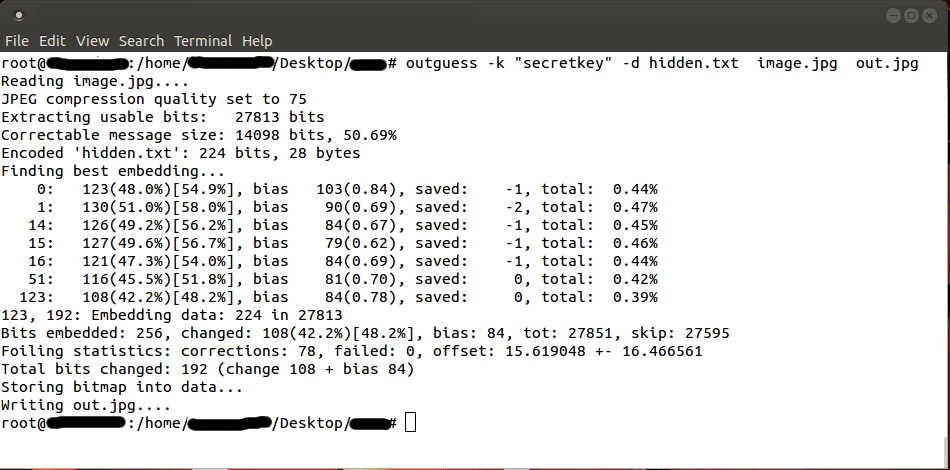
Jargon code, as the name suggests, uses language that is understood by a group of people but is meaningless to others.This category is subdivided into jargon codes and covered ciphers. The carrier message is sometimes called the overt communication, whereas the hidden message is the covert communication. Open codes hide a message in a legitimate carrier message in ways that are not obvious to an unsuspecting observer.A text semagram hides a message by modifying the appearance of the carrier text, such as subtle changes in font size or type, adding extra spaces, or different flourishes in letters or handwritten text. A visual semagram uses innocent-looking or everyday physical objects to convey a message, such as doodles or the positioning of items on a desk or Website. Semagrams hide information by the use of symbols or signs.
 Linguistic steganography hides the message in the carrier in some nonobvious ways and is further categorized as semagrams or open codes. Technical steganography uses scientific methods to hide a message, such as the use of invisible ink or microdots and other size-reduction methods. Classification of Steganography Techniques (Adapted from Bauer 2002)įigure 1 shows a common taxonomy of steganographic techniques (Arnold et al. Steganography_medium = hidden_message + carrier + steganography_keyįigure 1. The use of a steganography key may be employed for encryption of the hidden message and/or for randomization in the steganography scheme. The secret message is embedded in the carrier to form the steganography medium. The steganography process generally involves placing a hidden message in some transport medium, called the carrier. Steganography hides the covert message but not the fact that two parties are communicating with each other. Microdots and microfilm, a staple of war and spy movies, came about after the invention of photography (Arnold et al. Invisible ink has been in use for centuries-for fun by children and students and for serious espionage by spies and terrorists. In ancient times, messages were hidden on the back of wax writing tables, written on the stomachs of rabbits, or tattooed on the scalp of slaves. Nevertheless, this paper will treat steganography as a separate field.Īlthough the term steganography was only coined at the end of the 15th century, the use of steganography dates back several millennia. Although steganography is separate and distinct from cryptography, there are many analogies between the two, and some authors categorize steganography as a form of cryptography since hidden communication is a form of secret writing (Bauer 2002). This differs from cryptography, the art of secret writing, which is intended to make a message unreadable by a third party but does not hide the existence of the secret communication. The purpose of steganography is covert communication to hide a message from a third party. Steganography is the art of covered or hidden writing.
Linguistic steganography hides the message in the carrier in some nonobvious ways and is further categorized as semagrams or open codes. Technical steganography uses scientific methods to hide a message, such as the use of invisible ink or microdots and other size-reduction methods. Classification of Steganography Techniques (Adapted from Bauer 2002)įigure 1 shows a common taxonomy of steganographic techniques (Arnold et al. Steganography_medium = hidden_message + carrier + steganography_keyįigure 1. The use of a steganography key may be employed for encryption of the hidden message and/or for randomization in the steganography scheme. The secret message is embedded in the carrier to form the steganography medium. The steganography process generally involves placing a hidden message in some transport medium, called the carrier. Steganography hides the covert message but not the fact that two parties are communicating with each other. Microdots and microfilm, a staple of war and spy movies, came about after the invention of photography (Arnold et al. Invisible ink has been in use for centuries-for fun by children and students and for serious espionage by spies and terrorists. In ancient times, messages were hidden on the back of wax writing tables, written on the stomachs of rabbits, or tattooed on the scalp of slaves. Nevertheless, this paper will treat steganography as a separate field.Īlthough the term steganography was only coined at the end of the 15th century, the use of steganography dates back several millennia. Although steganography is separate and distinct from cryptography, there are many analogies between the two, and some authors categorize steganography as a form of cryptography since hidden communication is a form of secret writing (Bauer 2002). This differs from cryptography, the art of secret writing, which is intended to make a message unreadable by a third party but does not hide the existence of the secret communication. The purpose of steganography is covert communication to hide a message from a third party. Steganography is the art of covered or hidden writing. #Outguess orginial software#
Examples of software tools that employ steganography to hide data inside of other files as well as software to detect such hidden files will also be presented. Although this paper provides a historical context for steganography, the emphasis is on digital applications, focusing on hiding information in online image or audio files.


It is directed at forensic computer examiners who need a practical understanding of steganography without delving into the mathematics, although references are provided to some of the ongoing research for the person who needs or wants additional detail. This paper is intended as a high-level technical introduction to steganography for those unfamiliar with the field. The purpose of steganography is covert communication-to hide the existence of a message from a third party. Research and Technology An Overview of Steganography for the Computer Forensics ExaminerĪbstract | Introduction | Null Ciphers | Digital Image and Audio Digital Carrier MethodsĮxamples | Detecting Steganography | Tools | Summary and Conclusions | ReferencesĪdditional Websites | Companion Downloads | Commercial Vendors Forensic Science Communications - July 2004







 0 kommentar(er)
0 kommentar(er)
